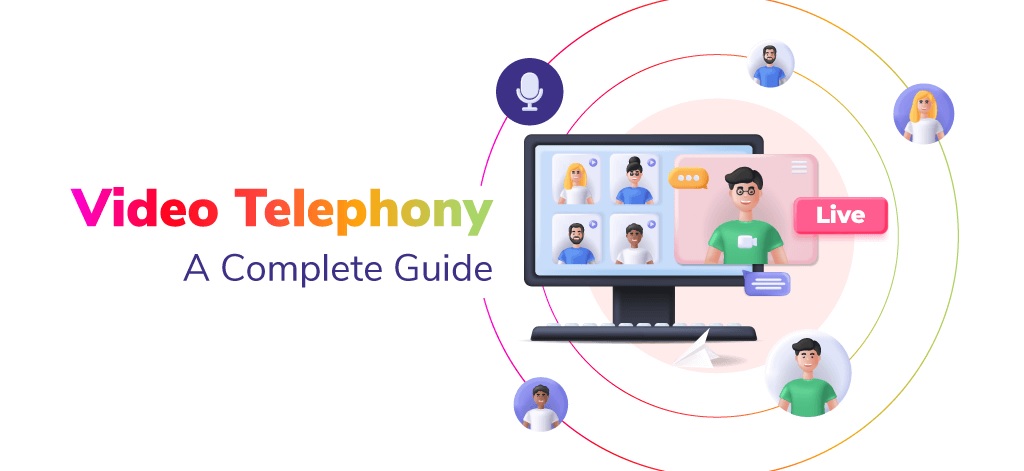Videotelephony, also known as video teleconference or videoconferencing, refers to modern technologies that enable individuals in various places to receive and transmit audio-visual signals for real-time communication. A videophone is a phone that features a video display and may be used for real-time visual and voice communication.
In contrast to individual video conferencing, videotelephony refers to the use of this technology for group or organizational meetings. A high-quality video-telephony system or meet-up technology, which goes beyond video and incorporates robots, are both examples of virtual reality. Videoconferencing is a form of collaborative technology commonly referred to as “visual collaboration”.
In this blog, we are going to discuss general queries about Videotelephony and its relevant areas. So without further ado, let’s start:
In a video call, what technology is used?
The majority of video conferencing nowadays is sent via a high-speed broadband Internet connection, utilizing VoIP (Voice over Internet Protocol)-like technology. However, LAN and occasionally ISDN connections are also used.
What is necessary for video conferencing?
Here is the list of things that are required for video conferencing:
- Webcams
- Microphones
- Multicamera setups
- Webcams with built-in microphones
- USB cameras
- Speakers
- VoIP (voice over IP) conference phone
- External speaker
- Computer’s built-in speakers
- WiFi and Ethernet for Internet access
- Video conferencing tools and apps, such as reliable video conferencing software.
How does video telephony work?
Using computer and communications technologies, videotelephony enables individuals in two or more places to see and hear each other at the same time.Webcams or multi-cam setups and streaming video are used to share visual data. You may distribute audio content via the phone or a computer.
Why would someone use a videophone?
Deaf and hard-of-hearing people who communicate with others using sign language can use a video phone to do so. The phones can be used by Deaf individuals to speak with each other over the phone or with hearing people via a sign language interpreter.
How do you set up a video conference?
- Send a meeting request with a video link attached.
- When it’s time for your virtual meeting, click the link.
- Participate in the conference call, share your screen, and benefit from face-to-face interaction.
Is using video conferencing challenging?
However, the reality of video conferencingis a mix of unpleasant social conventions still in development, poor technology, and complex software. for those who are suddenly forced into a life of working from home. It may be just as difficult to figure out how to call in as it is to learn how to behave during video chats.
What position should the camera be in during a video conference?
To facilitate face-to-face communication, try to place the camera at eye level. This is the most natural angle. If the camera is positioned too high or too low in relation to the meeting attendees, the video performance may suffer.
What are the video telephony dos and don’ts?
- Be prepared for the meeting and arrive on time.
- Test out your equipment.
- When you’re not talking, mute yourself.
- Cut back on interruptions.
- Look professional.
- Positioning and lighting the camera.
- Visuals to increase involvement.
- Pay attention to little details
What are the benefits of Video telephony or web conferencing?
Here are the significant benefits of video telephony in the current era:
1. Effective utilization of time and resources
The majority of video meetings, particularly those in which participants are coming in from multiple places, have a set beginning and ending time. People are more productive during the allotted period since they are aware that there is a limited amount of time available. Due to time constraints, attendees stick to the core agenda.
2. Better participation in business meetings
It might be challenging to coordinate everyone’s schedules so that they can all meet face-to-face in the same location. With a video connection, participants have more freedom; those in other time zones may join the meeting as well. The majority of software allows for the recording of meetings so that others who were unable to attend may still hear what was discussed.
3. Enhanced productivity and efficiency in organizations
Companies conduct daily video conversations to start the day and go through the strategy for the day because the majority of staff work remotely. Video calls are also used for all other customer meetings and internal team meetings. The daily journey to the workplace, suppliers, or clients is eliminated as a result. Consider it another way: You can wind up wasting hours commuting simply to get to a one- or two-hour meeting. One can be more productive and use the time saved on a trip by participating in a video call for more essential activities.
4. Helps strengthen client connections
Face-to-face interactions are always more effective at creating meaningful and lasting connections. Video calls offer the human element and a personal touch to one-on-one conversations, which consumers want the most, allowing businesses to develop stronger bonds with their customers and clients.
Videotelephony and Its Future
In the contemporary digital environment, videotelephony has emerged as a lifeline. Employee advantages go beyond simply increasing productivity. No matter the distance, people may collaborate on projects in real-time, take part in conversations via messaging or chat without interrupting the speaker, record calls for later listening, and do a lot more. Users may move between devices during a conversation without disconnecting thanks to today’s multi-device compatible video telephony solutions. They can also reduce background noise and ensure that a conference is completely uninterrupted. And this is only the start of videotelephony, or we can say videoconferencing; there is still much room for innovation and exploration in the field of videotelephony.
Closing Thoughts
By the end of this blog, you know the general queries regarding video conferencing. Video conferencing, or web conferencing, is a modern solution for business and organizational problems. Consider the above-mentioned queries and solutions whenever you’re planning a video conference setup. Hope you like the blog. Thank you for reading!




